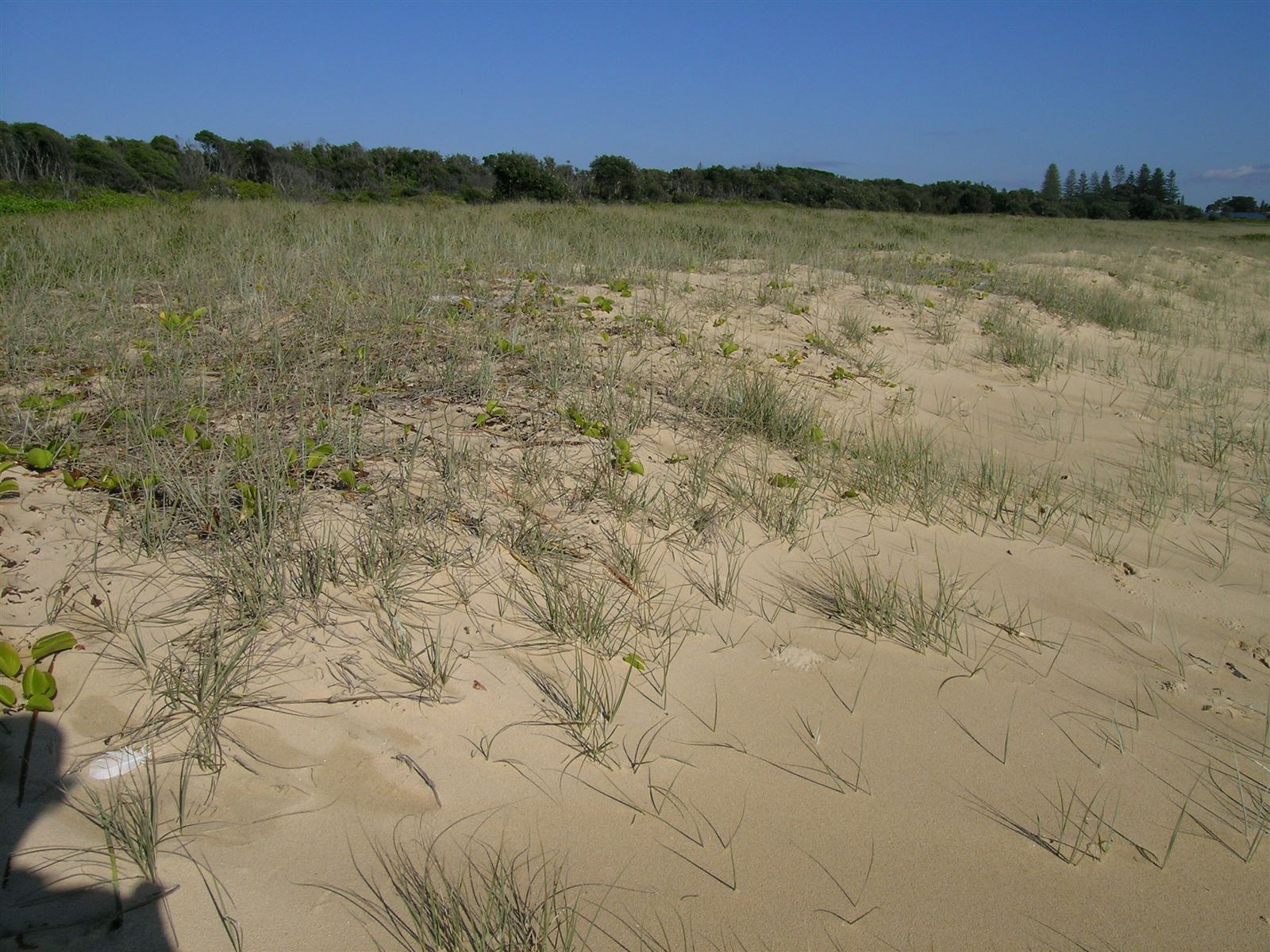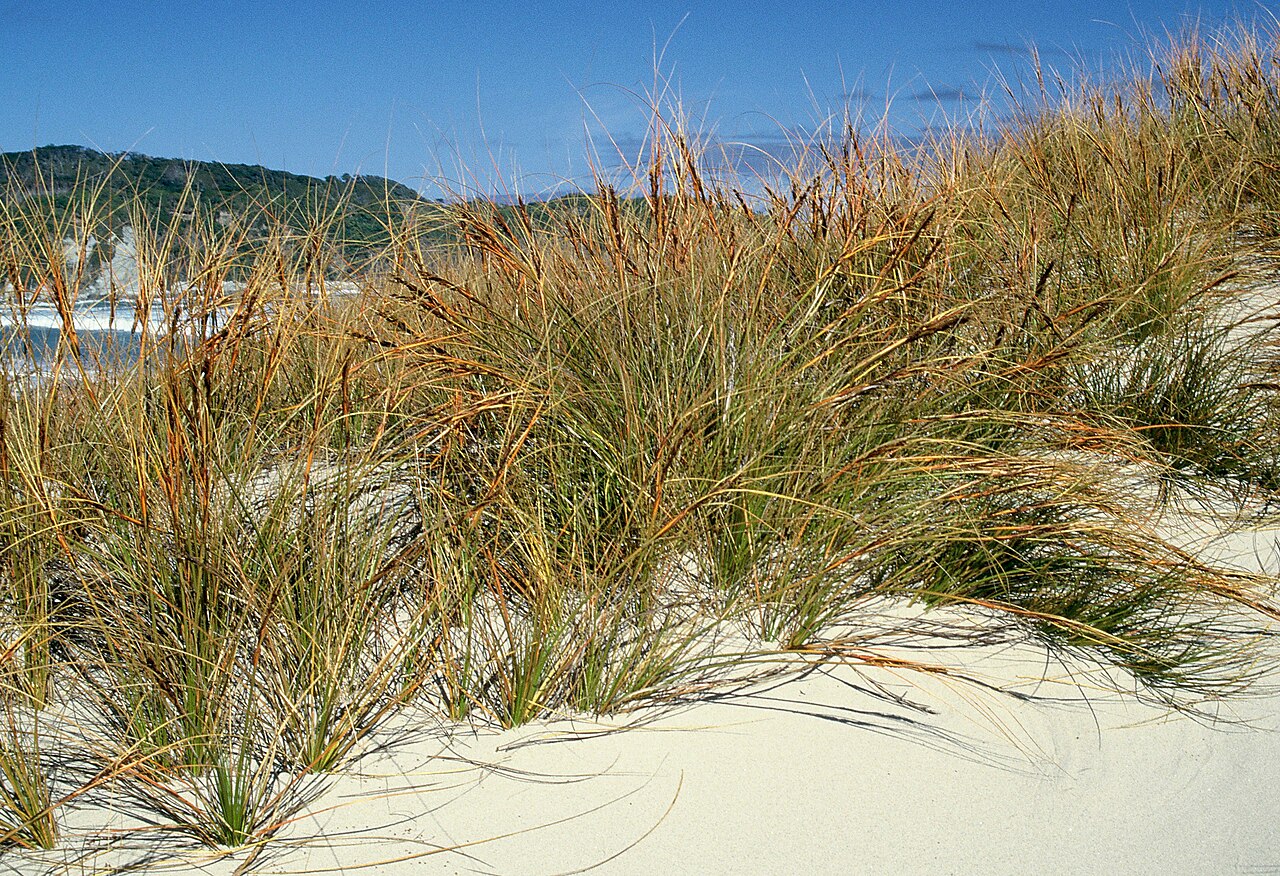Kōwhangatara (Spinifex sericeus)
Spinifex sericeus
Kōwhangatara (Spinifex sericeus), commonly known as Beach Spinifex, is a native sand-binding grass essential to New Zealand's coastal ecosystems. This pioneering species is perfectly adapted to harsh beach conditions with its silvery-gray foliage and remarkable ability to stabilize mobile sand dunes. The plant's distinctive runners can extend several meters across the sand, while its spherical seed heads break off when mature and tumble along beaches in the wind, distributing seeds across new areas. As a primary dune-builder, Spinifex plays a crucial ecological role in coastal protection and dune formation.

Image credit: Wikipedia
Quick Facts
| Height | 0.3-0.5 meters (foliage) |
|---|---|
| Water Needs | Low |
| Light | Full sun |
| Frost Tolerance | Moderate |
| Growth Rate | Fast (runners can extend 1-2m per year) |
| Lifespan | 5-15+ years |
Climate Best Suited To
Kōwhangatara is naturally found on coastal sand dunes throughout New Zealand, from Northland to Stewart Island. It thrives in the harsh conditions of the coastal environment, tolerating salt spray, strong winds, sand burial, and drought. However, it is specifically adapted to coastal conditions and generally won't thrive in inland gardens unless specific coastal conditions are recreated.
| City | Climate Suitability |
|---|---|
| Whangārei | Ideal |
| Auckland | Ideal |
| Hamilton | Challenging |
| Tauranga | Ideal |
| Rotorua | Unsuitable |
| Gisborne | Ideal |
| New Plymouth | Ideal |
| Napier | Ideal |
| Whanganui | Ideal |
| Palmerston North | Challenging |
| Wellington | Ideal |
| Nelson | Ideal |
| Christchurch | Ideal |
| Dunedin | Ideal |
| Queenstown | Unsuitable |
| Invercargill | Good |
Note: Suitability refers to coastal areas near these cities. Inland locations are generally unsuitable for Spinifex.
Growing Requirements
Soil Requirements
Kōwhangatara is highly specialized for growing in:
- Pure sand or very sandy soils
- Very free-draining conditions
- Low organic matter and nutrient levels
- Slightly alkaline to neutral pH (typical of shell-rich coastal sands)
- Will not tolerate clay soils or waterlogged conditions
Light Requirements
As a primary colonizer of open coastal dunes, Kōwhangatara requires:
- Full, direct sunlight
- Cannot tolerate shade or competition from taller plants
- Naturally grows in exposed locations
- Requires at least 8+ hours of direct sunlight daily
Water Requirements
Kōwhangatara is extremely drought-tolerant:
- Requires minimal watering once established
- Excessive moisture can lead to root rot
- Natural rainfall is usually sufficient even in dry coastal areas
- Young plants benefit from occasional watering during establishment
- Has deep roots to access moisture deep in the sand
Ecological Impact
Kōwhangatara plays a critical role in New Zealand's coastal ecosystems:
Dune Formation and Stabilization
- Acts as a primary sand-binding species that captures and holds wind-blown sand
- Creates the first line of dunes along beaches, which protect inland areas from storm surges and erosion
- Long runners trap sand, gradually building dunes over time
- Extensive root system helps stabilize mobile sand
Coastal Protection
- Natural buffer against coastal erosion and storm damage
- Helps beaches recover naturally after storm events
- Creates habitat for other coastal species, supporting biodiversity
- Forms part of the natural succession of coastal vegetation
Wildlife Habitat
- Provides shelter for native skinks and invertebrates
- Creates protected nesting areas for shore birds
- Stabilized dunes support a range of other native coastal plants
In recent times, Kōwhangatara has been increasingly used in dune restoration projects as communities recognize its importance in maintaining healthy, resilient coastlines. Replacing it with non-native species or removing it entirely can lead to significant coastal erosion problems.
Propagation Methods
From Seed
Growing from seed is possible but challenging:
- Collect ripe seed heads when they begin to detach easily (summer to autumn)
- Separate seeds from the fluffy seed head
- Sow immediately in pure sand or a very sandy mix
- Keep lightly moist until germination, which can be erratic
- Transplant carefully once seedlings are robust
Division
Division of established plants is the most reliable method:
- Dig up runners with some roots attached in spring or autumn
- Cut into sections approximately 20-30cm long, each with some roots
- Plant immediately into sand with the growing tip just above the surface
- Water lightly to settle the sand around the roots
- Space plants 1-2 meters apart to allow for spreading
For dune restoration projects, large-scale planting of divisions is the preferred method, with spacing calculated to achieve optimal coverage within 2-3 growing seasons.
Planting and Care
When to Plant
The best time to plant Kōwhangatara is during the cooler months of autumn or early spring when there is some natural rainfall to help with establishment. Avoid planting during hot, dry summer periods unless irrigation is available.
Planting Technique
- Dig a hole slightly larger than the root system
- Place the plant so that the crown is at or slightly above sand level
- Backfill with sand, firming gently
- Water thoroughly to settle sand around roots
- For dune planting, partially burying the stems can encourage rooting
Maintenance
- Minimal maintenance required once established
- No fertilizer needed or recommended
- Occasional watering during extended drought may help young plants
- Monitor for weed competition, especially introduced marram grass
- No pruning necessary - the plant will naturally spread via runners
Notes for Restoration Projects
For dune restoration work:
- Use locally-sourced plant material where possible for best adaptation
- Install sand traps or brushwood barriers to assist initial establishment
- Control foot traffic through newly planted areas
- Consider combining with other native sand-binding species like pīngao for more comprehensive dune stabilization
Cultural Significance
Kōwhangatara has significant cultural importance to Māori as a plant of the coastal environment:
Traditional Knowledge
- Recognized for its role in stabilizing coastal dunes and protecting inland areas
- The distinctive rolling seed heads (kowhangatara) gave the plant its Māori name
- Featured in traditional ecological knowledge about coastal processes
- Its presence indicated suitable landing sites for waka (canoes) as it grew on gradually sloping beaches
Traditional Uses
- The female seed heads were sometimes collected and used as toys for children
- Plants were deliberately maintained in some areas to protect settlements from sand encroachment
- Formed part of the understanding of coastal ecology and resource management
Contemporary Significance
Today, Kōwhangatara is increasingly valued in both Māori and wider New Zealand society for its ecological importance and role in coastal protection. Many community-led dune restoration projects prioritize this species, recognizing both its cultural and ecological significance in maintaining the health and resilience of New Zealand's coastlines.
Landscaping Uses
While primarily valued for ecological restoration, Kōwhangatara can also be used in specialized landscape settings:
Coastal Gardens
- Excellent for beachfront properties needing erosion control
- Creates a natural transition from beach to garden
- Silvery foliage provides distinctive texture and color
- Low maintenance ground cover for coastal sections
Specialized Applications
- Coastal public spaces and parks
- Sandy road verges near beaches
- Green roofs with very free-draining substrate
- Parking lot islands in coastal developments
Design Considerations
- Combine with other native coastal species like pīngao (Ficinia spiralis) for visual interest
- Allow plenty of space for natural spreading
- Use as a transition between built environments and natural beach areas
- Consider the tumbling seed heads as a seasonal feature
Note that Kōwhangatara is not suitable for standard garden settings away from the coast. It requires the specific conditions of coastal environments to thrive.
Bonus Tip
Create a "Living Coastal History" display by establishing a small demonstration area of Kōwhangatara alongside information about its role in both natural dune formation and cultural history. For properties near the coast, this can serve as both an educational feature and a practical erosion control measure. Include weatherproof interpretive signage explaining how the plant builds dunes and how it was viewed by both Māori and early European settlers. This not only showcases an important native species but helps visitors understand the dynamic nature of coastal environments and the ingenious adaptations of native plants to these challenging conditions.

